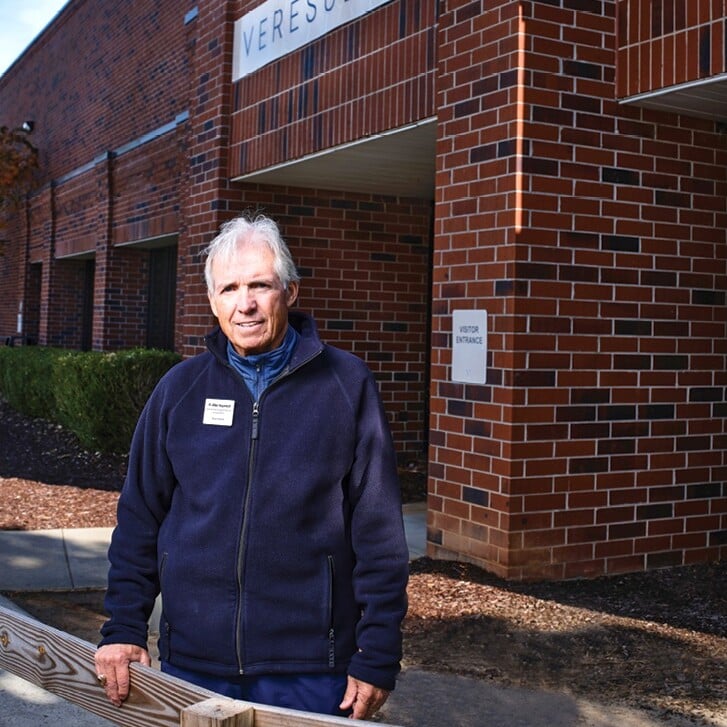Hancock County | Indomitable Spirit
Trains, tourism and teamwork.
Hancock County is rich in history, with hundreds of historic sites and structures, but many people, even lifelong Georgians, have  passed right by without stopping to visit. But if Sparta Mayor Allen Haywood, Hancock County Commission Chair Helen “Sistie” Hudson, Sparta-Hancock Chamber of Commerce President LaTunya Goodwin and other like-minded citizens have their way, Hancock County is on its way to reinventing itself – and putting itself back on the map.
passed right by without stopping to visit. But if Sparta Mayor Allen Haywood, Hancock County Commission Chair Helen “Sistie” Hudson, Sparta-Hancock Chamber of Commerce President LaTunya Goodwin and other like-minded citizens have their way, Hancock County is on its way to reinventing itself – and putting itself back on the map.
Hancock is one of the state’s larger counties in terms of land. Sparta, the county seat, is about halfway between Atlanta and Augusta, just a little south of Interstate 20. Hancock was founded in 1793 as Georgia’s 15th county and named after John Hancock.

Making Progress: Sparta Mayor
and Executive Director of the Sparta-Hancock Development Authority Allen Haywood, outside of Verescence, photo Matt Odom Photography.
In recent years, the county has had a stagnant economy. Hancock County officials say that’s primarily due to 67% of the county being in conservation easements, which affected the millage rate. One mill in Hancock County, for example, is worth $386,000, while it’s worth around $3.6 million in a neighboring county, according to county officials. They say in 2022, the county billed $5.7 million in property taxes. But Hudson says the county’s fortunes are slowly on the uptick.
Today, the major employers are Vulcan and Heidelberg Materials quarries – both among the world’s largest manufacturers of construction aggregates (50 to 60 jobs); Hancock State Prison (130-plus jobs); Verescence (220-plus jobs), a French company that’s the world’s largest manufacturer of perfume bottles, with U.S. operations in New York City and Georgia; the Hancock County School District (180-plus jobs); and the county, with around 150 employees.
Improvement Projects
“I’ve been here for 39 years. I was elected mayor in 2019, and Sparta has been in the black operationally for the last three years. We’re making progress and people see it,” says Haywood, who, in addition to being mayor of Sparta is also the executive director of the Sparta-Hancock County Development Authority, a position he’s held since 2012. Haywood grew up in nearby Warrenton, then moved to Sparta in 1984 when he purchased The Ishmaelite, a weekly newspaper he sold in 2005. He was re-elected mayor in November and says he wants to see three ambitious projects come to fruition.

Focus on Healthcare: Hancock County Commission Chair Helen “Sistie” Hudson helped Hancock launch its own county-operated ambulance service, photo Matt Odom Photography.
First on the list is a 4-1/2-mile-long rail spur that would connect Heidelberg Materials to the CSX rail tracks that run near state Route 16, diverting heavy and destructive truck traffic from downtown Sparta. Next, the development authority hopes to establish a new 80-acre industrial park near the new bypass currently under construction.
“The bypass will divert approximately 500 cargo and tractor-trailers per day from downtown Sparta. This opens up a little over three miles of property for development, such as a truck stop, grocery store, fast food or a strip shopping center,” says Haywood.
Also on the drawing board is a proposed 80-megawatt AC solar farm valued at $120 million, which would be a huge boost to the county’s tax digest, according to Haywood.
Lots of Rock in Hancock
Georgia is rich in geological resources. The U.S. Geological Survey says the state leads in the production of fuller’s earth (an absorptive clay containing minerals), kaolin and iron oxide pigments. It is a major producer of barite, dimension stone and feldspar. It produces cement, common clay, construction sand and gravel, crushed stone, gemstones and mica. Hancock County is an important producer of crushed stone, which is badly needed for big construction projects throughout the Southeast, especially along coastal Florida, Georgia and South Carolina.

New Foray: Ben Tarbutton III, president of Sandersville Railroad in neighboring Washington County, wants to build a rail spur in Hancock County, photo contributed.
The Vulcan Quarry is already on the CSX rail line. The Heidelberg Materials Sparta Quarry is not. Sandersville Railroad Company wants to change that. Ben Tarbutton is president of Sandersville Railroad in neighboring Washington County in the heart of Middle Georgia, and the third generation of Tarbuttons to lead the company. “This is a new foray for us and Hancock County,” says Tarbutton, who’s committed to building a spur connecting the Heidelberg Materials Quarry to an existing CSX line.
The project is not without controversy, with some residents refusing to sell the land needed to secure the new rail line. The route has already been reworked to accommodate concerns, and Tarbutton hopes the route can still be established without the eminent domain process that would be necessary to override holdouts. He notes the reduction of truck traffic will benefit residents for years to come.
“The Sandersville Railroad expects to handle by rail the equivalent of roughly 130 trucks per day or over 30,000 trucks per year once the Hanson Spur is complete, which will lower wear-and-tear on local and state roads while reducing air emissions,” says Tarbutton.
The spur will allow Heidelberg Materials to ship an additional 400,000 tons of crushed granite aggregate per year from the quarry. “We’re excited to help Hancock County grow its tax base and jobs by accessing its natural resources and making it more efficient to distribute throughout the state and the Southeast,” says Tarbutton. “Rail is also a more environmentally friendly source of transportation. Freight railroads are, on average, three to four times more fuel efficient than trucks. It will also take 20 construction jobs to complete the project.”
“This creates a lot of opportunity for both Heidelberg, Sandersville Railroad and the folks in Hancock County,” says Don Richards, general manager of the Georgia and South Carolina Aggregates for Heidelberg Materials North America. “This quarry has the potential to be one of Heidelberg Materials’ largest quarries in the Southeast with a lifespan of many, many decades. The group who works in this quarry is one of the best crews in the state and has always been willing to go work at other sites when sales were slow at Sparta. The new spur will create eight to 10 more permanent jobs averaging $90,000 with salary and benefits. We’ve got plans to build a bigger plant, which means another five to 10 high-wage jobs. Our desire is to hire within the county and build a strong local workforce,” he says.
Aside from the quarry, Tarbutton projects the spur will also be used to transport liquid asphalt, grain and wood chips. “This will be one of the largest investments ever in Hancock County,” says Tarbutton. “Sandersville Railroad is projecting investing $15 million to build out the spur and Heidelberg has said they’ll invest $30 million into expanding their quarry operations. We estimate it will produce a $1.5 million impact for Hancock County. That’s a big deal for a county that operates on a budget of about $11.1 million,” he says.
Our History Is Our Future
“We have the richest history in Georgia. Hancock County has by far the best history, and these stories need to be told,” says Hudson. This Hancock County native has been in politics, advocating for its citizens and economic development, since 1982. She was a state representative for 16 years, mayor of Sparta and has been head of the board of commissioners since 2016. She’s running again in 2024. It will be her 17th election.
According to Hudson, Hancock County is one of the most historic counties in Georgia – “from the story of Amanda America Dickson, who was the wealthiest Black woman of her time in the country, to Zach and Camilla Hubert, who were among the first African American landowners in Central Georgia. The Huberts had 12 children, all of whom attained college educations,” she says. “Eleven of the 12 graduated from Morehouse or Spelman College, and two went on to become presidents at Historically Black Colleges.”

Major Employer: The Vulcan Materials quarry is a supplier of construction aggregates, including gravel, sand and crushed stone, photo contributed.
There are hundreds of historically significant buildings throughout the county, and many are in poor condition. In the early 2000s, Hudson assisted with promoting the first historic survey in Hancock County, which documented over 600 antebellum structures. While many have not survived the neglect over the years, others are still standing through the assistance of the Georgia Trust for Historic Preservation.
As much as she treasures the past, Hudson is always looking toward the future. She’s been working closely with Haywood in his capacity as director of the development authority to ink a deal with a major global leader in beauty and skincare products, which would add more jobs to the region. If all goes well, the skincare company would be housed in the same facility where Verescence manufactures its perfume bottles, but it would require a large expansion of the facility.
In addition to attracting new businesses, another huge issue for Hudson and Hancock County is healthcare. To improve access to healthcare, the county recently began its own county-operated ambulance services. Hudson is also actively seeking a medical partner for an urgent care center. She proudly speaks of three female Hancock County students who are attending Mercer University School of Medicine and is hopeful they’ll return home to practice. The county purchased and restored a local doctor’s office and will offer free rent to encourage a doctor to practice there.
Hudson also is restoring two small buildings downtown that will be offered as business incubators.
“It’s fun doing this stuff,” says Hudson. “Progress is always good!”
Local Flavor
Festivals and History

Life-defining Experiences: LaTunya Goodwin inside Mount Zion Presbyterian Church, founded in 1813, photo contributed.
Hancock County has a number of signature events that bring the community together, says LaTunya Goodwin who is both president of the Sparta-Hancock County Chamber of Commerce and chair of the Sparta-Hancock County Development Authority.
She is especially enthusiastic about the Sparta-Hancock Pine Tree Festival & Fair, typically held on the last weekend in October. Goodwin says vendors “ring the phone off the hook,” even though she does very little soliciting. The event includes live music, carnival rides and games and a parade.
In addition to giving the county an economic boost, the festival also brings together members of the community and visitors from other areas. “People take a vacation to come to the festival. It’s a reunion of more than 500 of our citizens. The pine tree symbolizes resilience – it’s a symbol of our community.”
Another popular event is the Historic Pews & Pulpits Ramble. This is a wonderful opportunity to visit and learn about some of East Central Georgia’s most historic churches that “are tucked away, but not forgotten.” Hancock County’s own Mt. Zion Presbyterian Church was on the 2023 tour. Founded in 1813, it was part of the Mt. Zion community of wealthy cotton planters. This antebellum church building is now owned by the Hancock County Historical Trust. It’s preserved in an unrenovated state to convey its sense of history.
The Sparta Historic District Walking Tour is a must for history and architecture buffs. Tie on your walking shoes and visit 28 significant homes in Sparta’s National Register Historic District. The tour also includes the magnificent Hancock County Courthouse, a masterpiece of Victorian architecture. The cornerstone was laid in 1882, on what would have been George Washington’s 150th birthday. In August 2014, a fire engulfed the courthouse, destroying the clock tower and leaving just the exterior brick walls standing. Nicknamed “Her Majesty,” the courthouse was rebuilt two years later and received the prestigious Marguerite Williams Award from The Georgia Trust in the following year.
While historical walking tours and festivals are entertaining, perhaps Hancock’s biggest biggest asset is something more foundational. “I chose to live in Hancock County because of the people,” says Goodwin. “These are very genuine people. I’ve been the beneficiary of personal and life-defining experiences here. It’s like living in Mayberry.”
To learn more about what the Sparta-Hancock Chamber of Commerce calls “Georgia’s Hidden Jewel,” visit the website spartahancockchamber.com.







